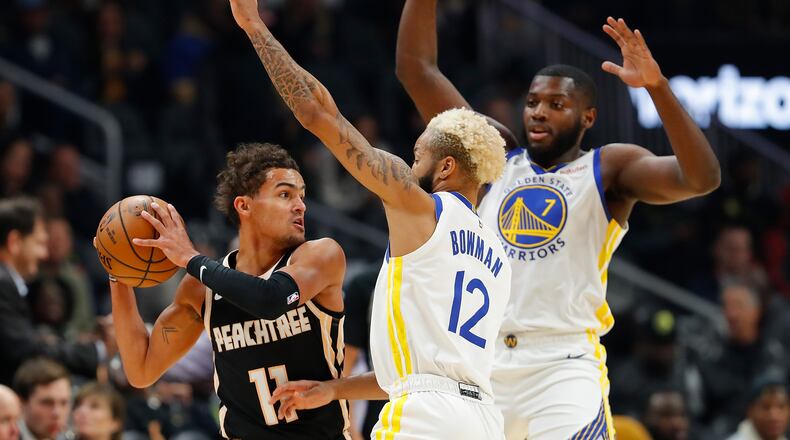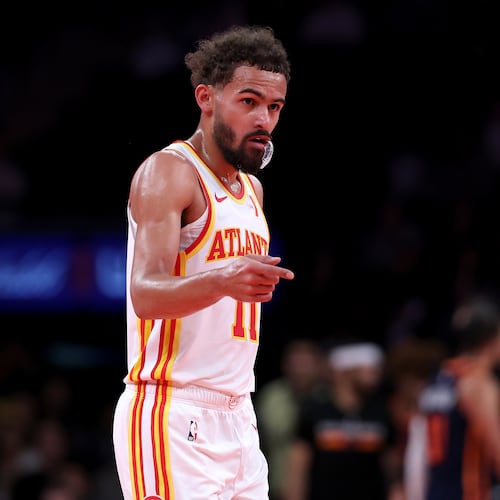At this point, in his second season with the Hawks, it’s not even that big of a story anymore when Trae Young has a 30-point, 10-assist double-double, when he swishes a 3-pointer from the logo or when he finds a teammate with a behind-the-back or no-look pass.
Those have become more and more common as the 21-year-old point guard and the face of the Hawks franchise comes into his own — and his competitors have taken notice.
“I’ve had a couple people in games, when they’re guarding me or in a deadball, they’ll whisper, they’ll come over and just talk to me and be like ‘You’re a bad m-f,’” Young said. “It’s just respect. It’s a respect thing. When you get trapped the way I do, guarded the way I do, for me, it’s a sign of respect and I embrace it.”
With Young knocking down shots like he is, the amount of attention he receives from opposing defenses adds up. Young is building off what he did as a rookie and has thus far avoided the shooting struggles he faced last November, when he shot 19.8% from 3-point range. He’s fourth in the league in scoring (28.7 points) and fifth in assists (8.4), and has led the Hawks in scoring in 15 out of their 22 games.
But for all Young’s efforts, the Hawks, playing shorthanded until John Collins is eligible to return from suspension Dec. 23 and only recently getting Kevin Huerter back from injury, have started off 5-17, with Young tallying 39 points and 10 assists in their loss to Brooklyn on Wednesday.
So Young brushes off his success on an individual level.
He’s always been that way. At Oklahoma, Young was the first player in Division I history to lead the nation in both points (27.4) and assists (8.7), since assists were made an official stat in 1983, according to ESPN Stats & Info. But the Sooners lost to Rhode Island in the first round of the NCAA Tournament.
“Even back at Oklahoma, I led the country in points and assists, and I was frustrated, almost after every game, whenever we’d lose,” Young said. “I had (48) at Oklahoma State and I couldn’t enjoy it because we lost. Those losses, when I play good, stick with me. Because I hate that feeling when I play good individually, numbers-wise, but we don’t win. Because you can’t enjoy it, especially if you’re a competitor like me.”
Heading into the Hawks’ game in Charlotte on Sunday, Young is shooting 46.3% from the field and 39.3% from 3-point range with an effective field-goal percentage of 54.7 (with a 60.5 true shooting percentage). All of those numbers are up from his rookie year, which makes sense, given the experience he’s gained.
“For me, I just know more,” Young said. “I think that’s the difference between guys coming into the league and guys who are veterans in this league. They just know more and they just feel more confident when you’re playing. So I’ve seen almost every, basically every type of defense you can throw at me. I’ve seen everything other teams have.”
Still, Young expects more of himself. With his size (6-foot-1, 180 pounds), Young often struggles on defense, and he’s averaging five turnovers a game.
“You can do a lot more,” Young said. “It’s crazy to say, it’s crazy to hear, but that’s just the realness. I think I can do a lot more. And whether it’s sliding over and taking charges on big men while they’re rolling, doing something. I can do more. I’ve just got to figure it out and find a way. I’ve got to figure it out and our team has to do a better job of figuring it out, too. We’ll get it right.”
Even last year, before Young’s 3-point shot started to fall, Hawks coach Lloyd Pierce recognized Young’s ability to create for both himself and others. Now, with the way he’s shooting, Young is putting it all together.
“Now you’re seeing the combination of his ability to create for others, to facilitate, his ability to create his own shot and the shots are going down,” Pierce said. “It’s kind of everything. You try and press up on him, he can get downhill and shoot his floaters like he did the other night (against Brooklyn). You go under his pick and rolls, he’s shooting 38, 39% from 3. So that’s pretty efficient.”
But that doesn’t mean, in Pierce’s eyes, that Young doesn’t still have room to grow.
“How do we cut his turnover margin down?” Pierce said. “He’s got the ball in his hands a ton. Maybe we cut the usage down, maybe we get him off the basketball a little bit more, maybe we free him up because he’ll get easier shots. He should be shooting 45% as opposed to 40% from 3.
“How do we get him into bodies and more physical defensively? Maybe he’s getting turnovers, creating turnovers, because he’s pressuring, he’s underneath the ball-handlers. So whatever he’s doing well at, I think he can do better at.”
About the Author
Keep Reading
The Latest
Featured


